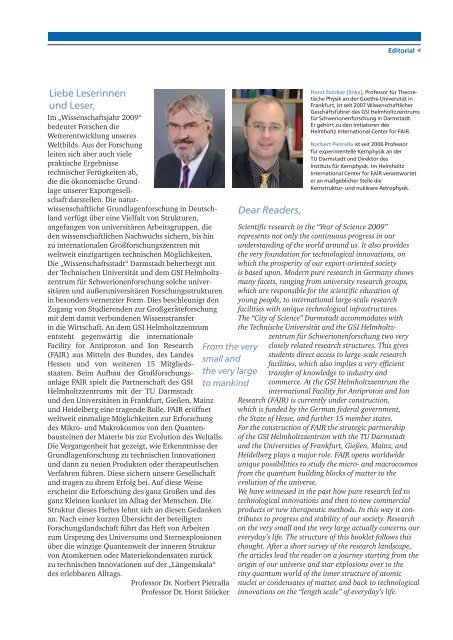forschen 1/2009 - Forschungscluster «Nuclear and Radiation Science
forschen 1/2009 - Forschungscluster «Nuclear and Radiation Science
forschen 1/2009 - Forschungscluster «Nuclear and Radiation Science
Sie wollen auch ein ePaper? Erhöhen Sie die Reichweite Ihrer Titel.
YUMPU macht aus Druck-PDFs automatisch weboptimierte ePaper, die Google liebt.
Liebe Leserinnen<br />
und Leser,<br />
Im „Wissenschaftsjahr <strong>2009</strong>“<br />
bedeutet Forschen die<br />
Weiterentwicklung unseres<br />
Weltbilds. Aus der Forschung<br />
leiten sich aber auch viele<br />
praktische Ergebnisse<br />
technischer Fertigkeiten ab,<br />
die die ökonomische Grundlage<br />
unserer Exportgesellschaft<br />
darstellen. Die naturwissenschaftliche<br />
Grundlagenforschung in Deutschl<strong>and</strong><br />
verfügt über eine Vielfalt von Strukturen,<br />
angefangen von universitären Arbeitsgruppen, die<br />
den wissenschaftlichen Nachwuchs sichern, bis hin<br />
zu internationalen Großforschungszentren mit<br />
weltweit einzigartigen technischen Möglichkeiten.<br />
Die „Wissenschaftsstadt“ Darmstadt beherbergt mit<br />
der Technischen Universität und dem GSI Helmholtzzentrum<br />
für Schwerionenforschung solche universitären<br />
und außeruniversitären Forschungsstrukturen<br />
in besonders vernetzter Form. Dies beschleunigt den<br />
Zugang von Studierenden zur Großgeräteforschung<br />
mit dem damit verbundenen Wissenstransfer<br />
in die Wirtschaft. An dem GSI Helmholtzzentrum<br />
entsteht gegenwärtig die internationale<br />
From the very<br />
small <strong>and</strong><br />
the very large<br />
to mankind<br />
Facility for Antiproton <strong>and</strong> Ion Research<br />
(FAIR) aus Mitteln des Bundes, des L<strong>and</strong>es<br />
Hessen und von weiteren 15 Mitgliedsstaaten.<br />
Beim Aufbau der Großforschungsanlage<br />
FAIR spielt die Partnerschaft des GSI<br />
Helmholtzzentrums mit der TU Darmstadt<br />
und den Universitäten in Frankfurt, Gießen, Mainz<br />
und Heidelberg eine tragende Rolle. FAIR eröffnet<br />
weltweit einmalige Möglichkeiten zur Erforschung<br />
des Mikro- und Makrokosmos von den Quantenbausteinen<br />
der Materie bis zur Evolution des Weltalls.<br />
Die Vergangenheit hat gezeigt, wie Erkenntnisse der<br />
Grundlagenforschung zu technischen Innovationen<br />
und dann zu neuen Produkten oder therapeutischen<br />
Verfahren führen. Diese sichern unsere Gesellschaft<br />
und tragen zu ihrem Erfolg bei. Auf diese Weise<br />
erscheint die Erforschung des ganz Großen und des<br />
ganz Kleinen konkret im Alltag der Menschen. Die<br />
Struktur dieses Heftes lehnt sich an diesen Gedanken<br />
an. Nach einer kurzen Übersicht der beteiligten<br />
Forschungsl<strong>and</strong>schaft führt das Heft von Arbeiten<br />
zum Ursprung des Universums und Sternexplosionen<br />
über die winzige Quantenwelt der inneren Struktur<br />
von Atomkernen oder Materiekondensaten zurück<br />
zu technischen Innovationen auf der „Längenskala“<br />
des erlebbaren Alltags.<br />
Professor Dr. Norbert Pietralla<br />
Professor Dr. Horst Stöcker<br />
Dear Readers,<br />
Editorial ◀<br />
Horst Stöcker (links), Professor für Theoretische<br />
Physik an der Goethe-Universität in<br />
Frankfurt, ist seit 2007 Wissenschaftlicher<br />
Geschäftsführer des GSI Helmholtzzentrums<br />
für Schwerionenforschung in Darmstadt.<br />
Er gehört zu den Initiatoren des<br />
Helmholtz International Center for FAIR.<br />
Norbert Pietralla ist seit 2006 Professor<br />
für experimentelle Kernphysik an der<br />
TU Darmstadt und Direktor des<br />
Instituts für Kernphysik. Im Helmholtz<br />
International Center for FAIR verantwortet<br />
er an maßgeblicher Stelle die<br />
Kernstruktur- und nukleare Astrophysik.<br />
Scientific research in the “Year of <strong>Science</strong> <strong>2009</strong>”<br />
represents not only the continuous progress in our<br />
underst<strong>and</strong>ing of the world around us. It also provides<br />
the very foundation for technological innovations, on<br />
which the prosperity of our export-oriented society<br />
is based upon. Modern pure research in Germany shows<br />
many facets, ranging from university research groups,<br />
which are responsible for the scientific education of<br />
young people, to international large-scale research<br />
facilities with unique technological infrastructures.<br />
The “City of <strong>Science</strong>” Darmstadt accommodates with<br />
the Technische Universität <strong>and</strong> the GSI Helmholtzzentrum<br />
für Schwerionenforschung two very<br />
closely related research structures. This gives<br />
students direct access to large-scale research<br />
facilities, which also implies a very efficient<br />
transfer of knowledge to industry <strong>and</strong><br />
commerce. At the GSI Helmholtzzentrum the<br />
international Facility for Antiproton <strong>and</strong> Ion<br />
Research (FAIR) is currently under construction,<br />
which is funded by the German federal government,<br />
the State of Hesse, <strong>and</strong> further 15 member states.<br />
For the construction of FAIR the strategic partnership<br />
of the GSI Helmholtzzentrum with the TU Darmstadt<br />
<strong>and</strong> the Universities of Frankfurt, Gießen, Mainz, <strong>and</strong><br />
Heidelberg plays a major role. FAIR opens worldwide<br />
unique possibilities to study the micro- <strong>and</strong> macrocosmos<br />
from the quantum building blocks of matter to the<br />
evolution of the universe.<br />
We have witnessed in the past how pure research led to<br />
technological innovations <strong>and</strong> then to new commercial<br />
products or new therapeutic methods. In this way it contributes<br />
to progress <strong>and</strong> stability of our society. Research<br />
on the very small <strong>and</strong> the very large actually concerns our<br />
everyday’s life. The structure of this booklet follows this<br />
thought. After a short survey of the research l<strong>and</strong>scape,<br />
the articles lead the reader on a journey starting from the<br />
origin of our universe <strong>and</strong> star explosions over to the<br />
tiny quantum world of the inner structure of atomic<br />
nuclei or condensates of matter, <strong>and</strong> back to technological<br />
innovations on the “length scale” of everyday’s life.


